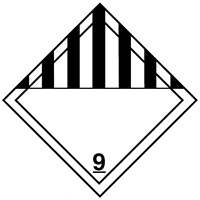
 Print
Print
Chemical Datasheet
LATEX, [LIQUID CONTAINING ACRYLONITRILE] |

|
Chemical Identifiers
| CAS Number |
UN/NA Number |
DOT Hazard Label |
USCG CHRIS Code |
|
none
|
|
|
|
| NIOSH Pocket Guide |
International Chem Safety Card |
|
none
|
none
|
NFPA 704
data unavailable
General Description
Used as an adhesive, as a binder in paper and textiles.
Hazards
Reactivity Alerts
Air & Water Reactions
No rapid reaction with air. No rapid reaction with water.
Fire Hazard
Special Hazards of Combustion Products: If the latex dries out and then burns, hydrochloric acid, hydrogen cyanide and styrene gases may be evolved. All are irritating and poisonous.
Behavior in Fire: Heat may coagulate the latex and form sticky plastic lumps which may burn. (USCG, 1999)
Health Hazard
Irritation of eyes. (USCG, 1999)
Reactivity Profile
LATEX, [LIQUID CONTAINING ACRYLONITRILE] is an aqueous emulsion containing particles of polymerized acrylonitrile. Forms stickly films by loss of water when exposed to the air at temperatures exceeding the glass transition temperature of the polymer [Kirk-Othmer, 4th Edition 15:55]. May react vigorously with strong oxidizing agents. Combustion produces toxic oxides of nitrogen.
Belongs to the Following Reactive Group(s)
- Nitriles
- Acrylates and Acrylic Acids
- Polymerizable Compounds
Potentially Incompatible Absorbents
Use caution: Liquids with this reactive group classification have been
known to react with the
absorbents
listed below.
- Cellulose-Based Absorbents
- Mineral-Based & Clay-Based Absorbents
- Dirt/Earth
Response Recommendations
Isolation and Evacuation
Excerpt from ERG Guide 171 [Substances (Low to Moderate Hazard)]:
IMMEDIATE PRECAUTIONARY MEASURE: Isolate spill or leak area in all directions for at least 50 meters (150 feet) for liquids and at least 25 meters (75 feet) for solids.
SPILL: Increase the immediate precautionary measure distance, in the downwind direction, as necessary.
FIRE: If tank, rail tank car or highway tank is involved in a fire, ISOLATE for 800 meters (1/2 mile) in all directions; also, consider initial evacuation for 800 meters (1/2 mile) in all directions. (ERG, 2024)
Firefighting
Excerpt from ERG Guide 171 [Substances (Low to Moderate Hazard)]:
CAUTION: Fire involving Safety devices (UN3268) and Fire suppressant dispersing devices (UN3559) may have a delayed activation and a risk of hazardous projectiles. Extinguish the fire at a safe distance.
SMALL FIRE: Dry chemical, CO2, water spray or regular foam.
LARGE FIRE: Water spray, fog or regular foam. Do not scatter spilled material with high-pressure water streams. If it can be done safely, move undamaged containers away from the area around the fire. Dike runoff from fire control for later disposal.
FIRE INVOLVING TANKS: Cool containers with flooding quantities of water until well after fire is out. Withdraw immediately in case of rising sound from venting safety devices or discoloration of tank. ALWAYS stay away from tanks in direct contact with flames. (ERG, 2024)
Non-Fire Response
Excerpt from ERG Guide 171 [Substances (Low to Moderate Hazard)]:
Do not touch or walk through spilled material. Stop leak if you can do it without risk. Prevent dust cloud. For Asbestos, avoid inhalation of dust. Cover spill with plastic sheet or tarp to minimize spreading. Do not clean up or dispose of, except under supervision of a specialist.
SMALL DRY SPILL: With clean shovel, place material into clean, dry container and cover loosely; move containers from spill area.
SMALL SPILL: Pick up with sand or other non-combustible absorbent material and place into containers for later disposal.
LARGE SPILL: Dike far ahead of liquid spill for later disposal. Cover powder spill with plastic sheet or tarp to minimize spreading. Prevent entry into waterways, sewers, basements or confined areas. (ERG, 2024)
Protective Clothing
Chemical goggles or face shield. (USCG, 1999)
DuPont Tychem® Suit Fabrics
No information available.
First Aid
Flush eyes with water for at least 15 min. (USCG, 1999)
Physical Properties
Chemical Formula:
data unavailable
Flash Point: data unavailable
Lower Explosive Limit (LEL): data unavailable
Upper Explosive Limit (UEL): data unavailable
Autoignition Temperature:
Not flammable
(USCG, 1999)
Melting Point: data unavailable
Vapor Pressure: data unavailable
Vapor Density (Relative to Air): data unavailable
Specific Gravity:
1.057
at 77°F
(USCG, 1999)
- Denser than water; will sink
Boiling Point:
Very high
(USCG, 1999)
Molecular Weight: data unavailable
Water Solubility: data unavailable
Ionization Energy/Potential: data unavailable
IDLH: data unavailable
AEGLs (Acute Exposure Guideline Levels)
No AEGL information available.
ERPGs (Emergency Response Planning Guidelines)
No ERPG information available.
PACs (Protective Action Criteria)
No PAC information available.
Regulatory Information
EPA Consolidated List of Lists
No regulatory information available.
CISA Chemical Facility Anti-Terrorism Standards (CFATS)
No regulatory information available.
OSHA Process Safety Management (PSM) Standard List
No regulatory information available.
Alternate Chemical Names
- LATEX, LIQUID SYNTHETIC
- LATEX, [LIQUID CONTAINING ACRYLONITRILE]
- PLASTIC LATEX
- SYNTHETIC RUBBER LATEX


 Print
Print
